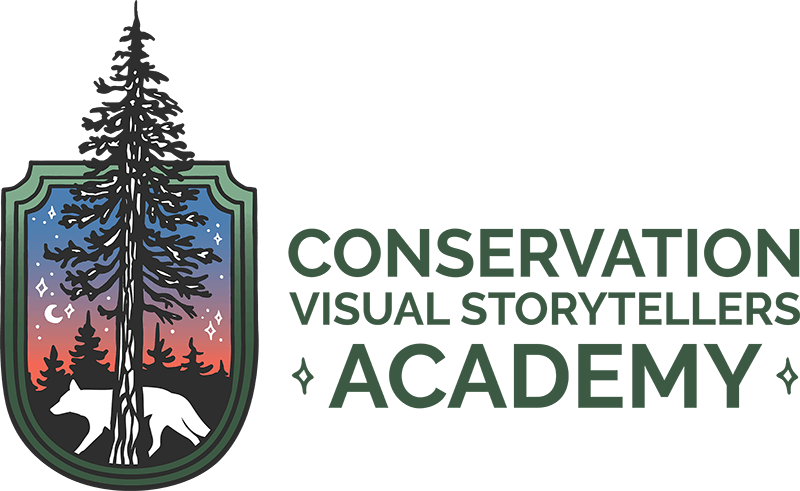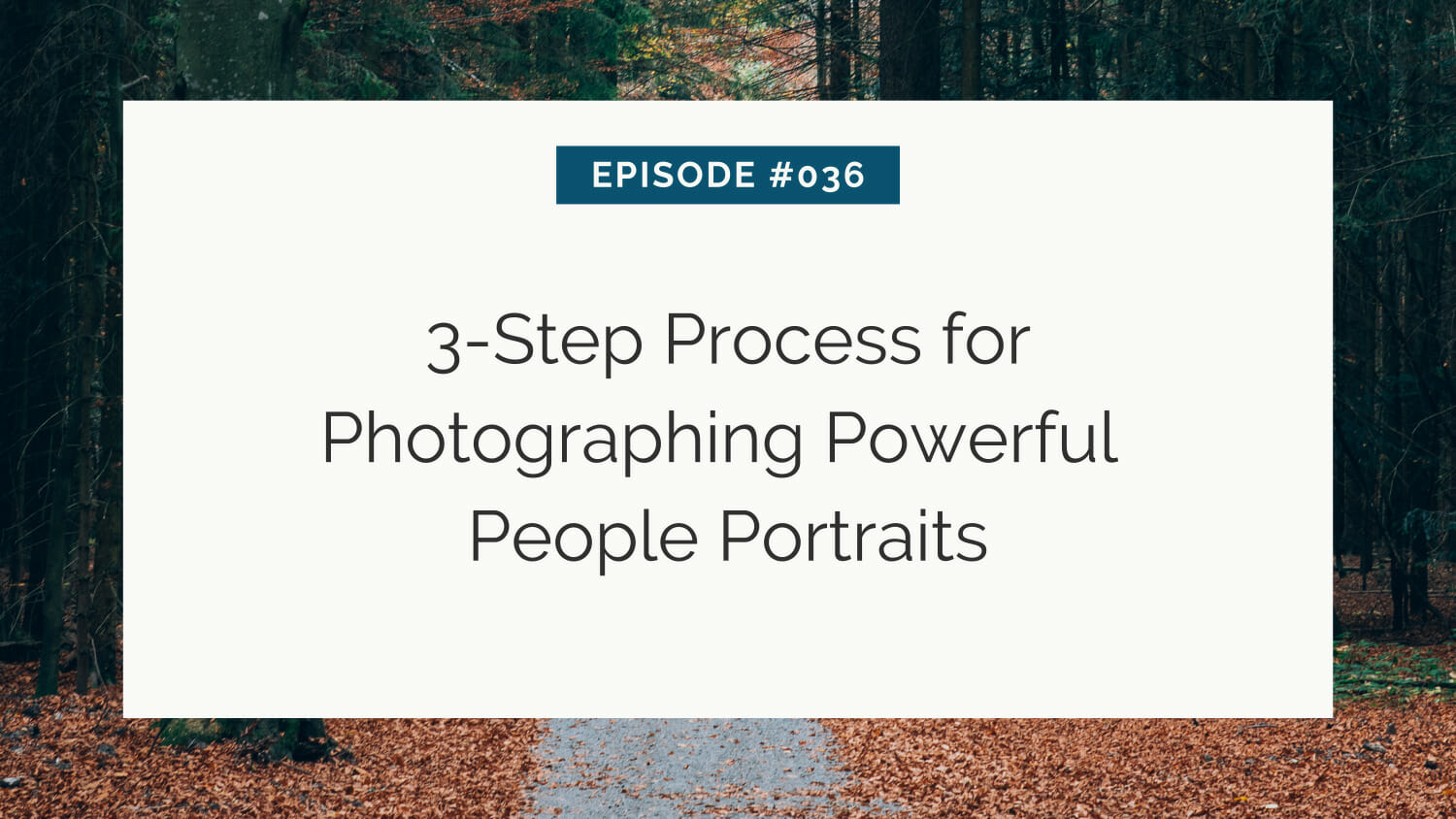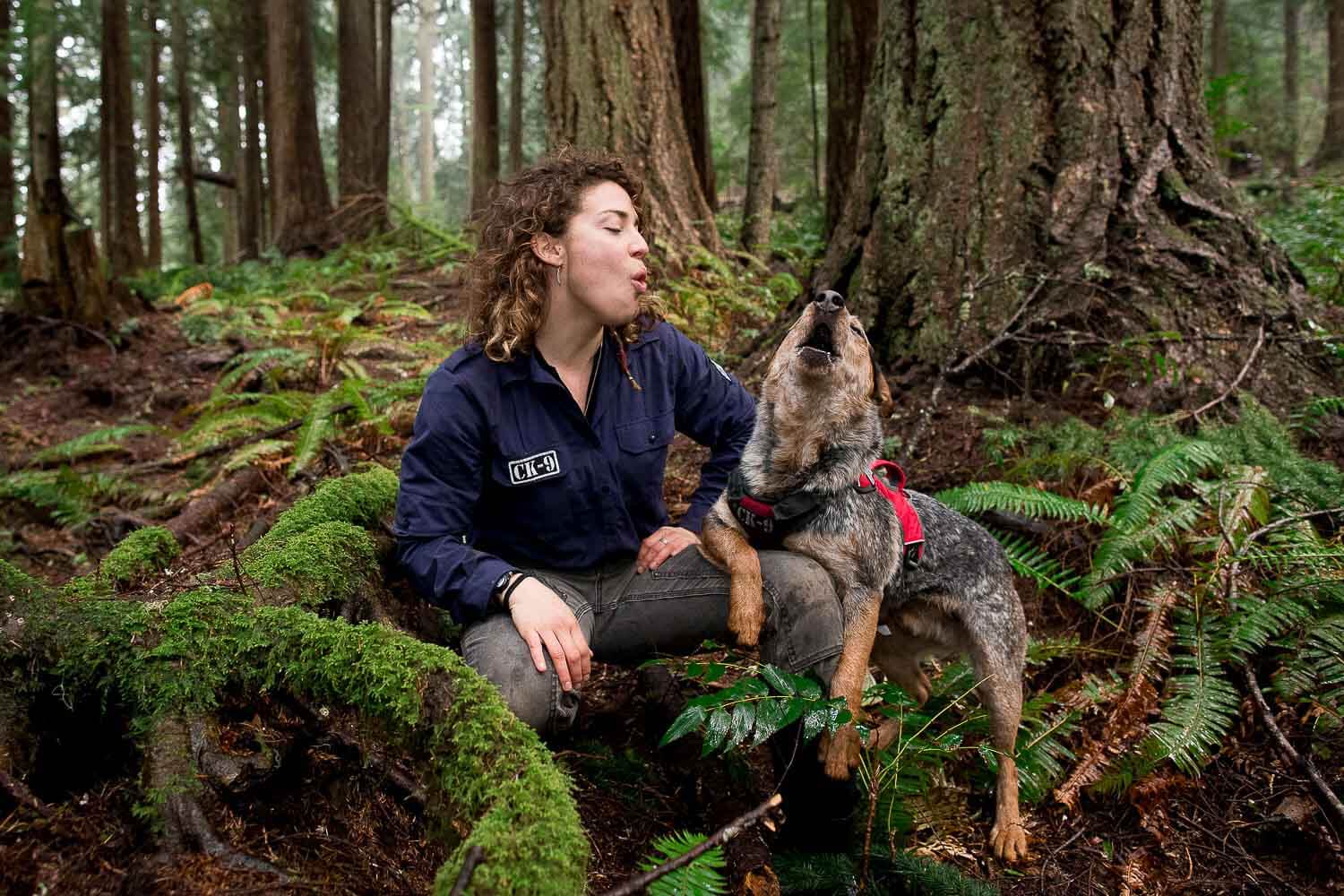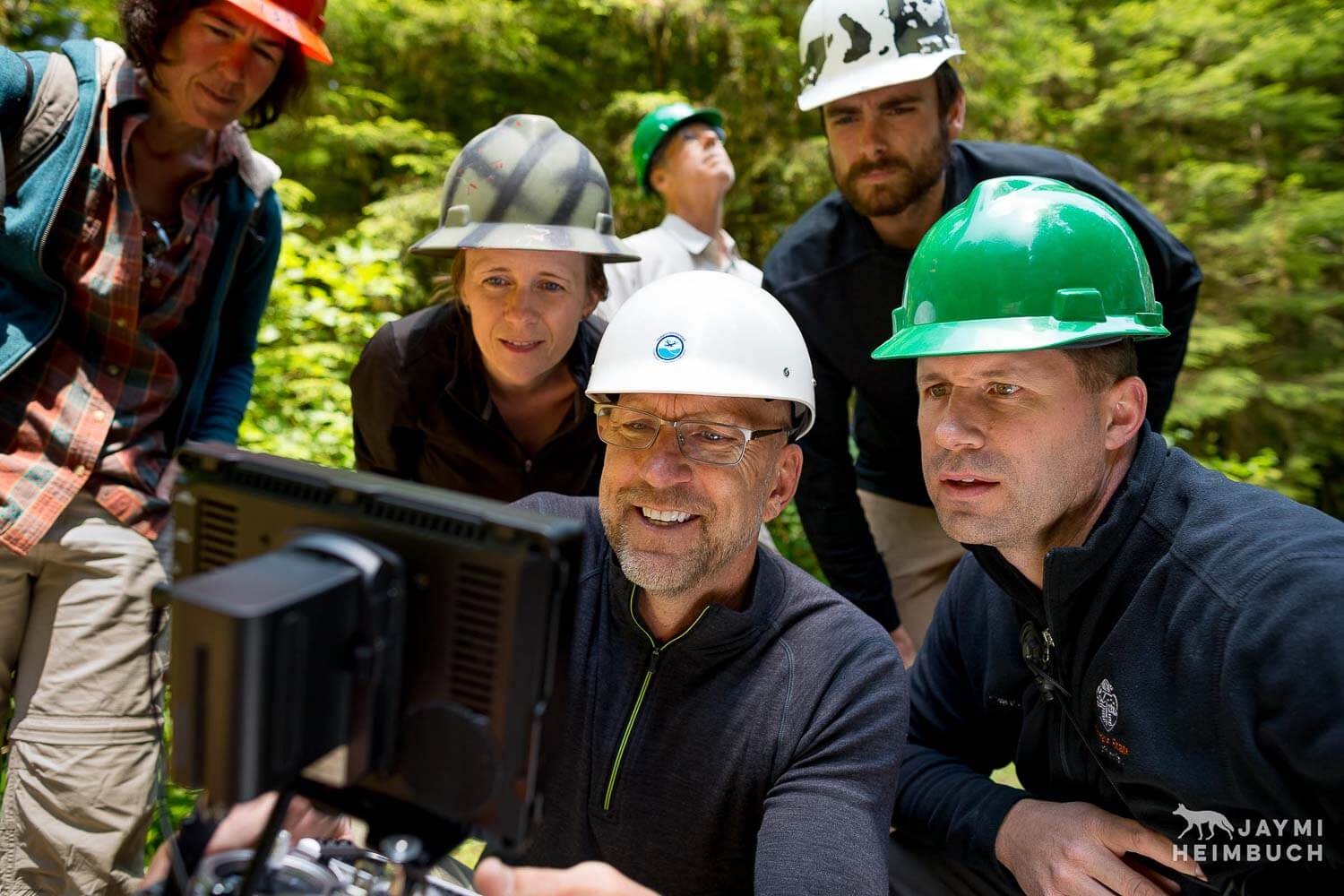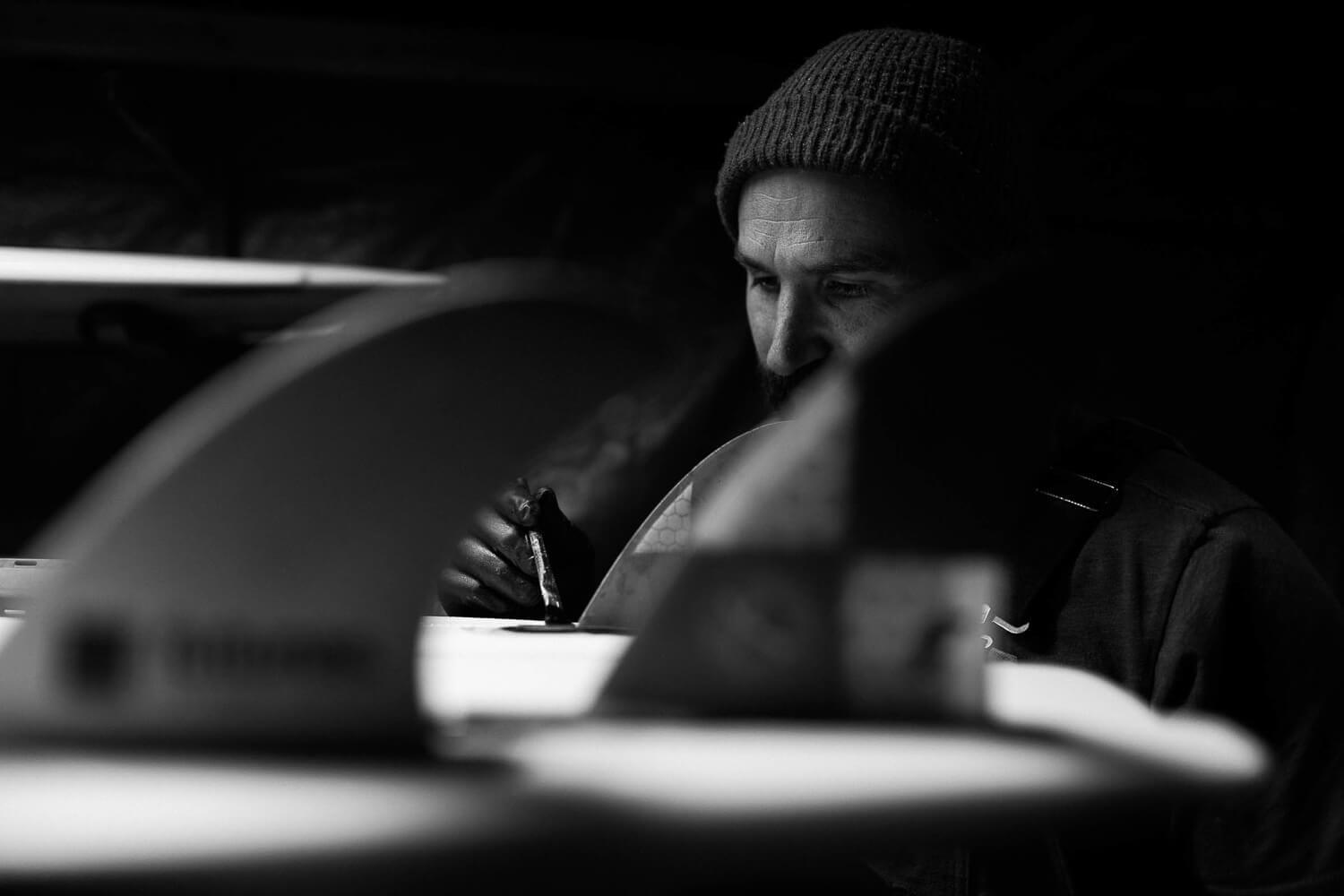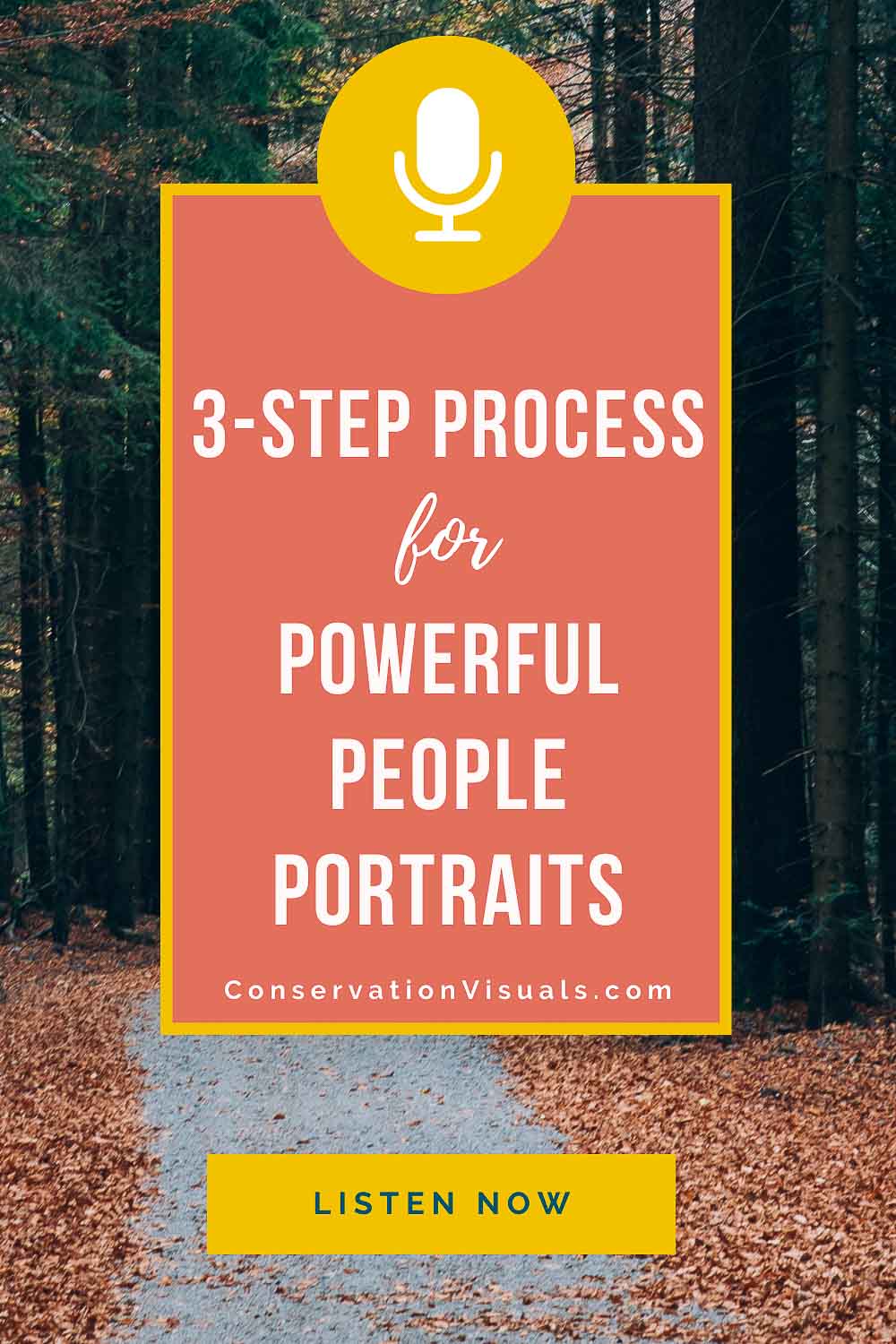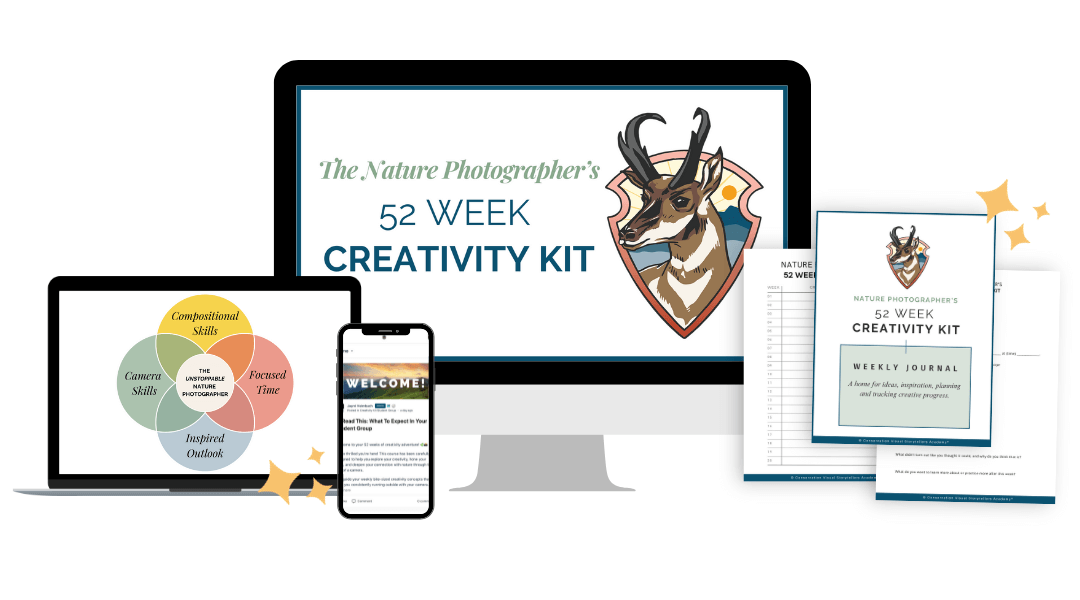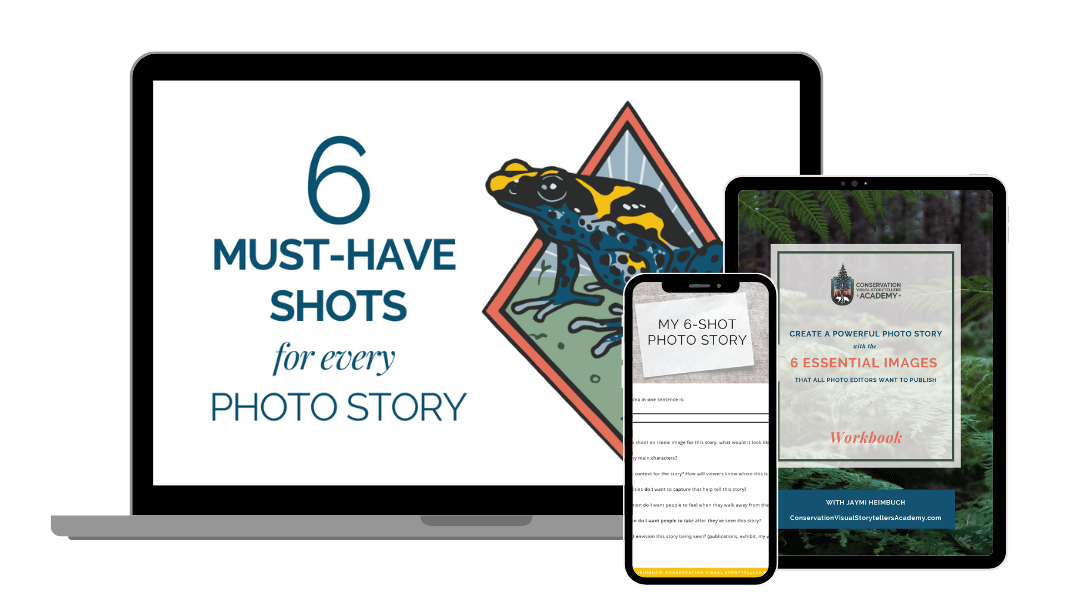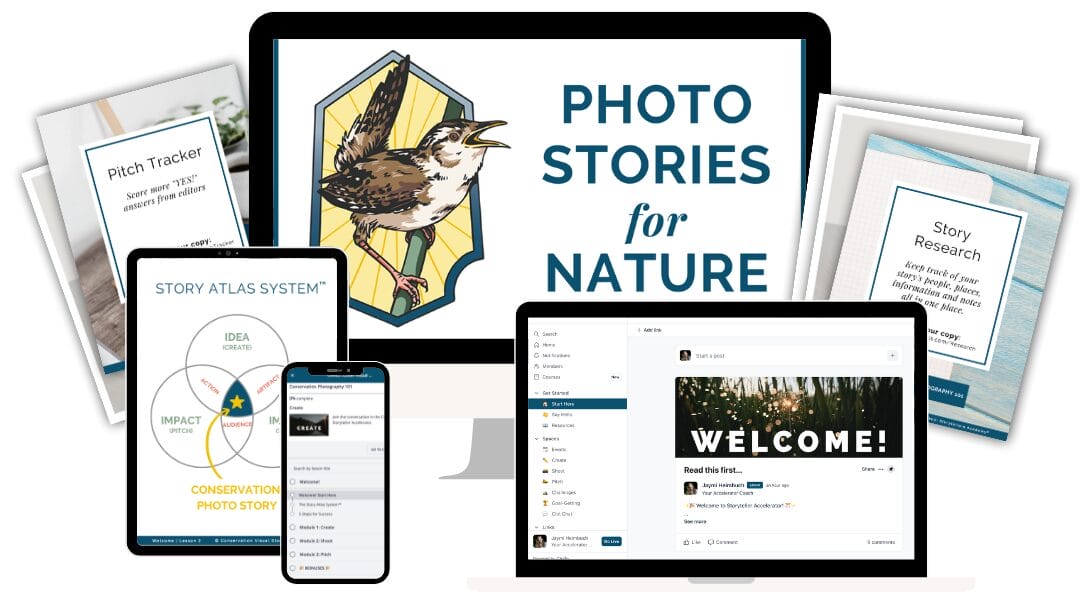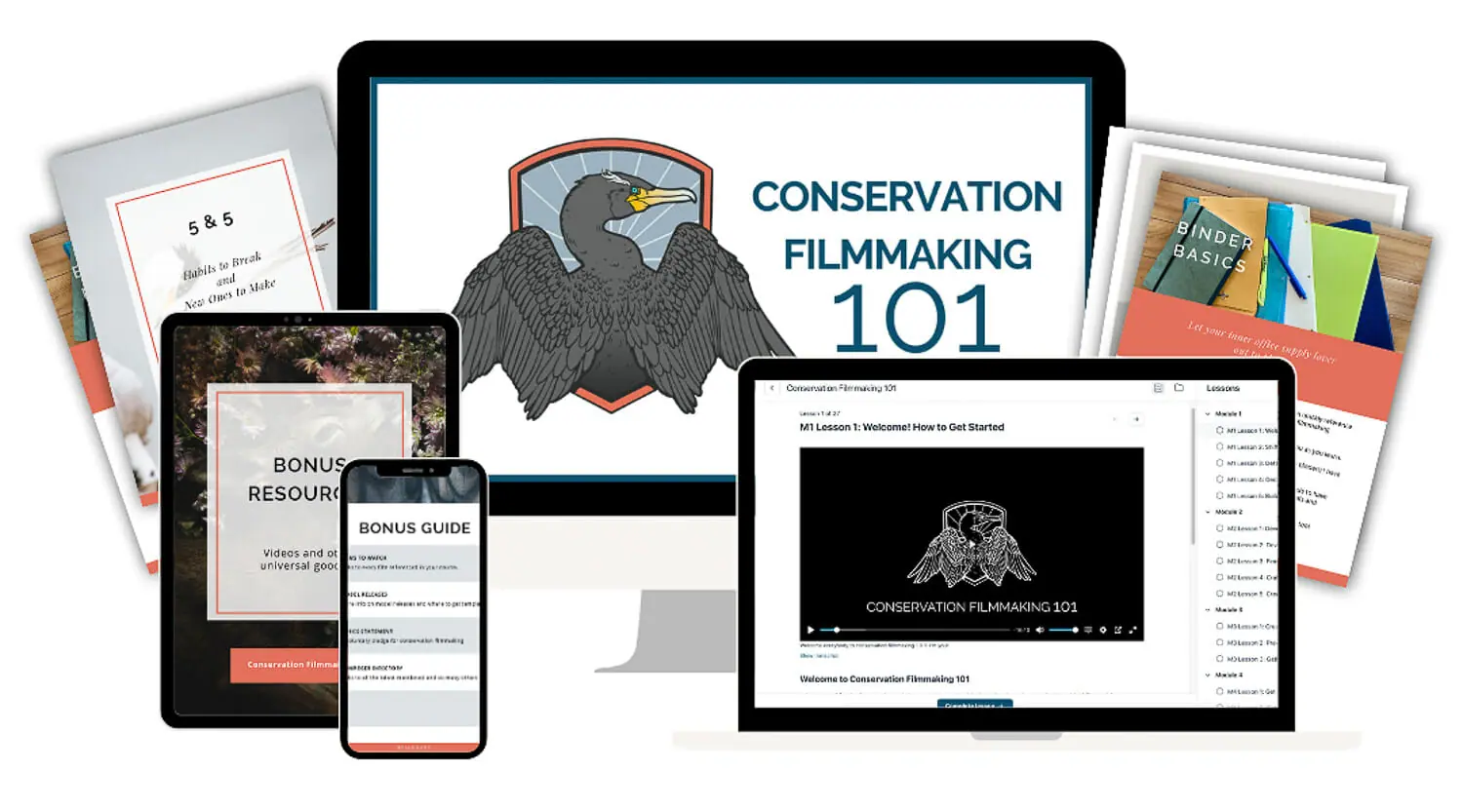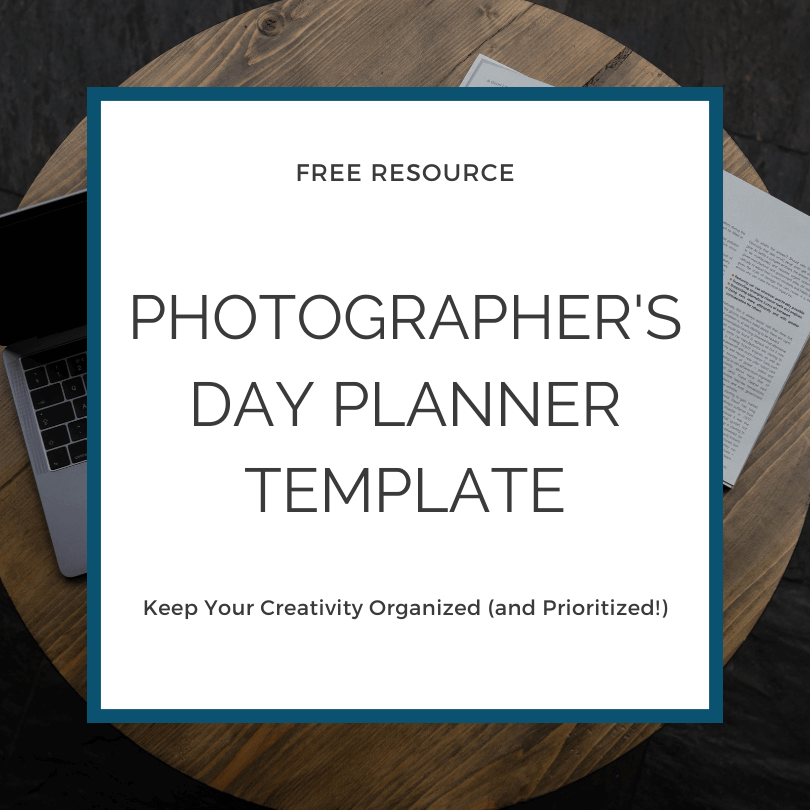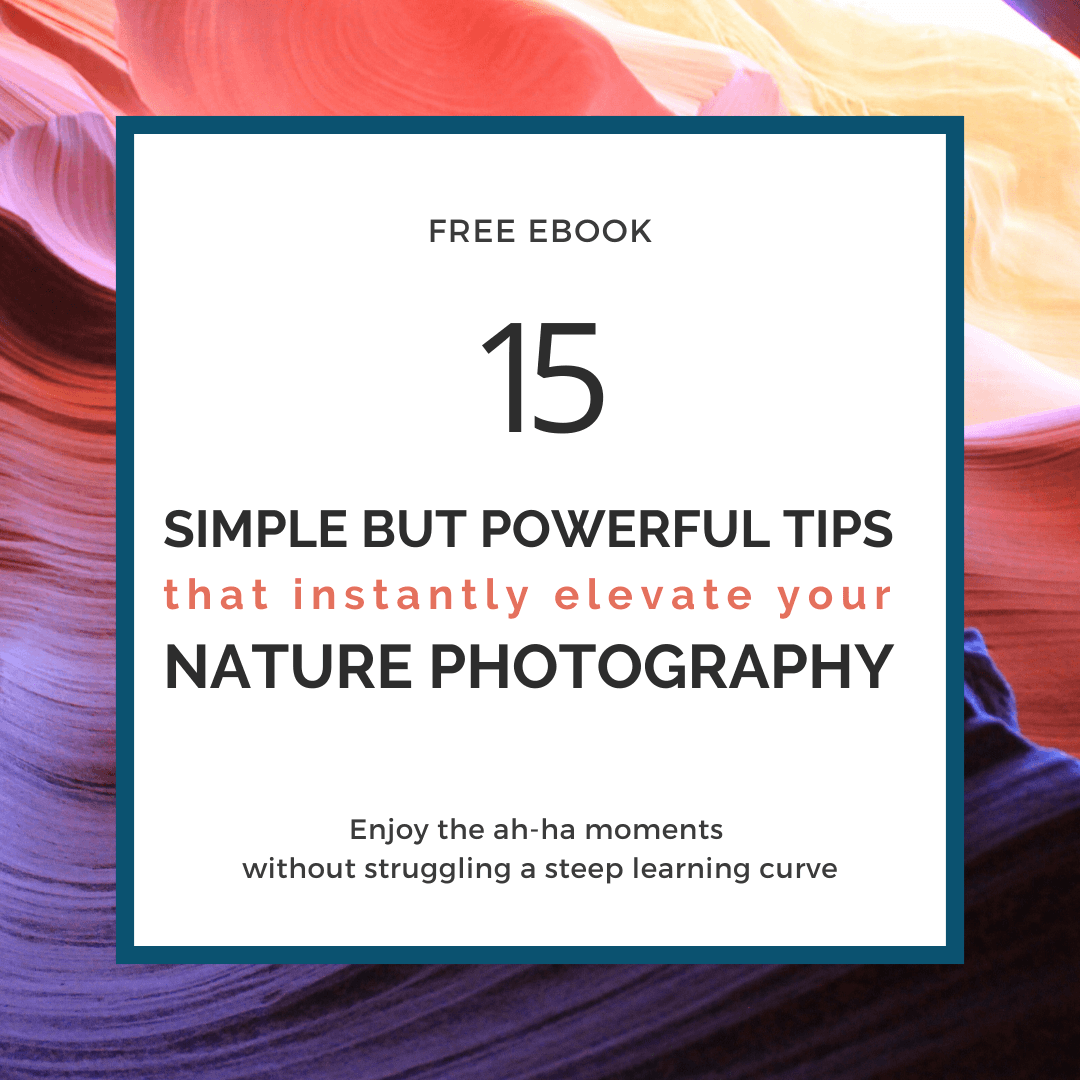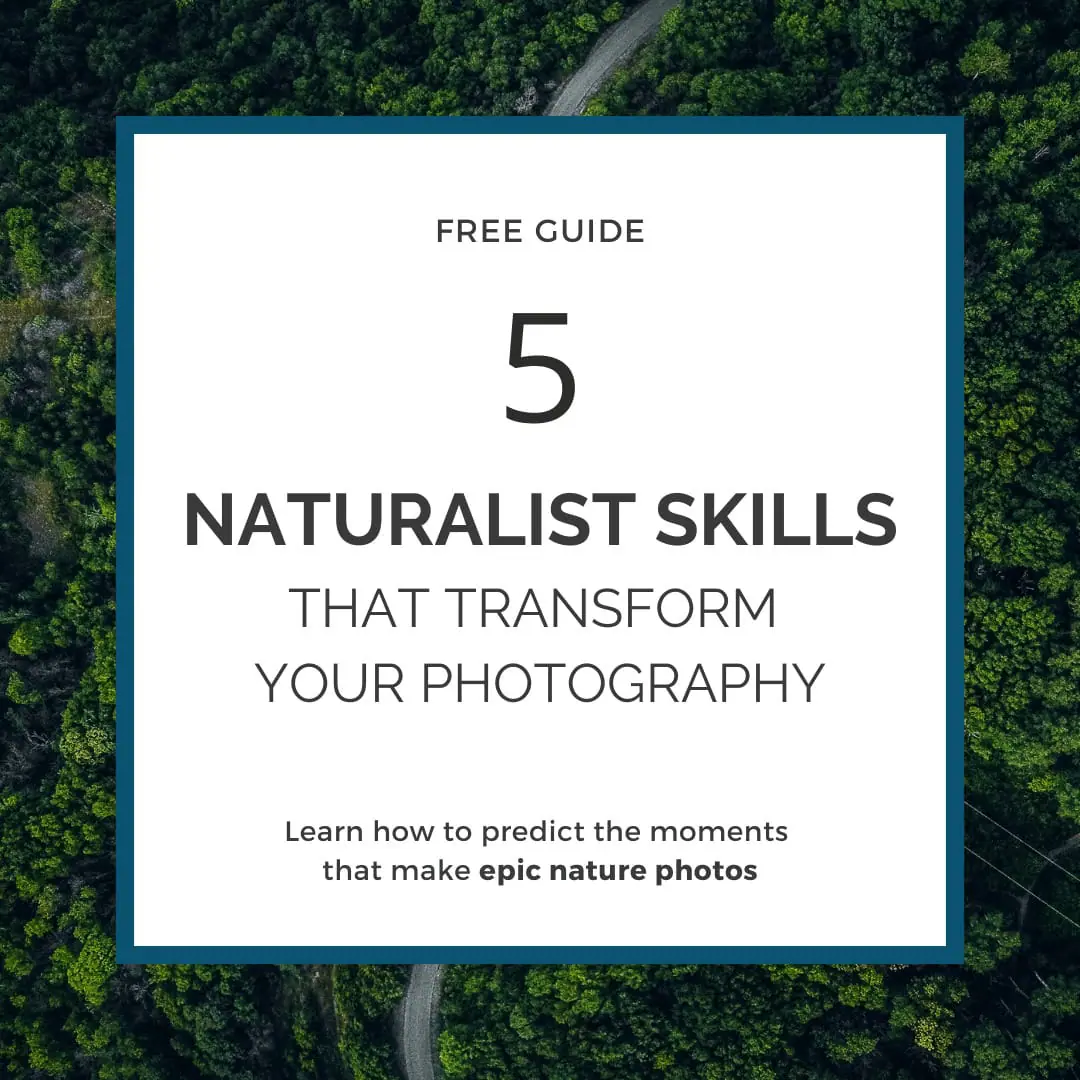3-Step Process for Photographing Powerful People Portraits
Feel awkward when photographing people? Totally understandable. But a conservation story isn't complete without those amazing images of people.
So, we're walking through a simple exercise to help you get comfortable and craft those powerful human portraits that are so critical to effective photo stories.
Easy exercises to build your confidence and creativity when photographing people
Conservation photographers tend to come from a background of wildlife or landscape photography. People photography is often either uncharted or uncomfortable territory. We feel awkward or intrusive holding a camera in front of someone, and that discomfort makes it hard to capture those decisive and emotional moments.
Yet… every quality photo story NEEDS a human element.
Pictures of people are what get viewers to pause, to look deeper, to connect, to ask questions that help them understand a conservation issue even more, and maybe even act on it.
So, if you’re looking to push past your inner squirm and start photographing powerful people portraits, then this episode is for you. I walk you through a “building blocks” style process that helps you get into the moments, and capture the kinds of images that make a conservation story effective in creating change.
Photo: Jaymi Heimbuch
Why photos of people are important to nature conservation photo stories
It is rare to find a conservation photo story that is complete without images of people.
There's almost always people involved in a conservation issue, whether that's:
- researchers and biologists who are studying the species or habitat that you're documenting
- people who are impacted by a conservation issue
- people who are the cause of the issue in the first place
there are all sorts of different characters that factor into a story and photographing them in a way that explorers or explains their significance to the story is so essential to helping viewers understand the story as a whole.
But it's not just any photos of people that will do.
There's a big difference between a photo of someone and a photo about someone.
Photos that don't contribute much to a story often feel static, featuring subjects who appear uncomfortable, are awkwardly posed, or (gasp, but it happens), photos of people's backs to the camera as they're doing some activity.
Images like these – where faces aren't visible or where there's a general awkwardness – don't resonate with viewers.
Simple snapshots or mundane company newsletter-style photos won't do the trick either.
If your photos don't capture emotion, they won't evoke it in your audience either.
For viewers to connect and empathize with a photo, it must be compelling and reveal the subject's identity, actions, feelings, and their role in the broader story.
Picture this: two photographers standing shoulder to shoulder at a public event.
Photographer One is merely documenting. They're not really sure how to read the situation or really judge the emotions of the people that are involved in this event. They're the one that getting those standard shots for the newspaper, the ones that you see next to the story, that's just that, Hey, look, we got a picture to go with the blurb kind of shots.
Photographer Two, however, can read the emotions of individuals in the crowd, as well as the mood of the crowd itself. They're watching how things are playing out. They're paying attention. They're looking for those decisive moments. That, moment in time when something is just at the beginning of happening, right at that peak of activity and getting into position to create frames that pull you as the viewer into that moment, both in activity and in emotion.
That is the photographer who is getting World Press Photographer of the Year level photos.
I want you to be that second photographer.
So how do you get images like that? Well, it comes down to two core skill sets.
Skill Set 1: Building Great Relationships
You've probably come across situations where people were not comfortable with you taking their pictures.
It's almost impossible to capture a good image when your subject feels uneasy or guarded.
The photographers who consistently capture those candid moments, those emotional peaks, are usually the ones who can quickly build rapport with their subjects, even with a camera between them.
This ability largely stems from the photographer's own confidence behind the lens. When you're confident and comfortable, you can make your subject feel the same. The stronger your confidence in your skills, the more comfort you can instill in your subjects, and the better your chances of capturing those magical moments that make for incredible portraits.
A crucial tip for capturing engaging portraits is to establish a genuine rapport with your subjects before aiming your camera at them.
This initial interaction can set the tone for the entire shooting process.
Start by showing genuine interest in them as individuals, converse about their interests, listen to their stories and share a few of yours.
This kind of pre-photography interaction can relax your subjects, make them trust you, and make them feel valued.
This results in them letting their guard down, allowing you to capture more authentic and emotive moments when you finally start shooting.
The camera does not create a barrier between you and the subject, but a bridge, and it's much easier to cross that bridge if you've laid a good foundation first.
Skill Set 2. Mastering Composition
The second vital skill set in people photography is comprehending the nuances of compelling composition.
This involves more than just framing a subject within the viewfinder.
You also need to read and interpret body language, facial expressions, and the interactions between your subjects and their environment—a skill that often requires a degree of empathy and emotional intelligence.
When reading body language, pay attention to subtle cues: a slight shift in posture, a clenched fist, or a fleeting expression can add significant depth to your photos by revealing your subject's emotional state.
Genuine emotions often come in fleeting moments, so being ready, observant, and patient is key.
Also factor in how seemingly mundane elements can affect the shot.
For instance, the way your subject’s sunglasses reflect the surroundings, how their hat casts shadows on their face, or how wind-blown hair conveys a sense of motion or adds drama to the image. These elements, while seemingly trivial, can significantly influence the mood and aesthetic of your shot.
Achieving a balance between these different elements is a dance between the left (logical) and right (creative) sides of your brain.
The left side is responsible for assessing the technical aspects of the shot—lighting, focus, and framing—while the right side contributes by weaving in creativity, emotion, and intuition. This harmonious collaboration can transform a simple snapshot into a profound portrait.
Tying It All Together
So, we have our two core skill sets for effective people photography: building quick and instant rapport with subjects and mastering the art of reading people and situations to create intriguing compositions.
But how do you gain these skills, especially if you're not used to photographing people, and you don't yet have that foundational confidence?
Fear not! I have a process you can follow.
If you commit to this process step by step, you'll gradually see your confidence grow, camaraderie with your subjects increase, and your compositional skills soar.
Step One: Choosing Your Lens
Let's dive straight into the first step. Pick a lens – just ONE lens – to work with.
Restriction fosters focus and creativity, so it's important to think more about composition and less about lens choices.
I recommend a prime lens. This encourages more focus on the scene unfolding before you.
Instead of zooming in and out to establish your composition, you're observing the scene, moving your body to adjust your perspective and frame.
This simple restriction can help you be more present in the moment and enhance your composition skills.
The lenses of choice would be a 50mm or a 35mm.
These are excellent for beginners photographing people as they allow you to balance the human subject within their environment.
With a wide or standard lens, you're not just capturing their face, but putting them in a context that communicates something about them.
Photo: Jaymi Heimbuch
Step Two: Begin with Familiar Faces
The next big step is to start with photographing family and friends.
This is a strategic move to build up your confidence level.
Your family and friends might not be instantly comfortable in front of the camera but it's your job to help them relax.
Your goal is to make your photography a common occurrence that they barely notice.
This practice makes you adept at recognizing and capturing fleeting moments of joy, sadness, or connection, all the while ensuring a good composition.
Let's look at two feasible strategies to boost your confidence in people photography.
STRATEGY 1: Casually document family activities or friendly gatherings.
The idea is to make your picture-taking so routine that it eventually goes unnoticed.
Maintain a low profile, quietly capturing moments of genuine emotion and activity without disrupting the flow.
This is an excellent practice for honing your ability to anticipate moments and subtly capture images that reflect the ambiance, mood and fleeting instances of joy, sadness, or connection.
It's a stepping stone towards confidently photographing events or groups.
STRATEGY 2: Partner with a willing friend or family member to document a specific activity
For example, if you have a friend who's an avid gardener, document their gardening activities.
As you join them in the garden, interact with them naturally while they go about their work.
Seek to understand what the activity means to them to capture the right emotions.
This practice bolsters your confidence in working one-on-one with a subject, helping them feel at ease in front of the camera while you get the storytelling shots you need.
This exercise can also involve posed portraits in the environment, an opportunity to practice your lighting and direction skills.
Both strategies aim to build your confidence and skills in working with subjects one-on-one.
Step Three: Broaden Your Scope
After you've built a foundation of confidence, it's time to expand beyond the circle of people you're comfortable with.
This is where your conversation skills come into play.
Building rapport with someone is quite simple – listen to them and show genuine interest in their story. As they open up, genuine moments will naturally unfold for you to capture.
It's great to start with someone you're already working with or connected with in some way.
For instance, if you're a volunteer for a nonprofit, opportunities for photographic exploration are endless. Begin by documenting the nonprofit's events or activities. The mutual commitment to a shared cause eases the initial discomfort, making people more open to being photographed.
In addition to event photography, you might also consider initiating a portrait series of the other volunteers. This not only allows you to practice your skills but also adds a personal touch to your portfolio, showcasing the human faces behind the collective effort.
Building rapport and getting comfortable with people you're less familiar with will not only bolster your confidence but further hone your skills in people photography.
Mastering conversation skills is crucial in people photography, just as much as handling your camera.
Building rapport is straightforward; all you have to do is listen and care.
When you genuinely care about knowing what makes someone tick, what they think and how they feel, what they're doing, then they're going to feel really comfortable sharing that with you. This comfort invites candid moments that you can capture, resulting in more authentic and compelling portraits.
So practice your conversation skills, your interview skills, ask simple questions, listen deeply, then ask follow-up questions and listen deeply again, really genuinely care to learn about this person that you're photographing.
And soon enough, your subject will relax and you'll know enough about them to know how you need to photograph them in order to create these beautiful portraits.
BONUS: Study the Work of Others
Finally, one valuable tip is to examine closely the work of your favorite conservation photographers, particularly their photographs involving people.
Ask yourself what elements you love in their shots – is it the composition, the captured moment, or the activity within the photo that draws you in?
What technical skills have they utilized to achieve perfect lighting or capture motion effectively?
It's crucial to study how these photographers have used images of people within conservation narratives to advance the story.
This can significantly guide you in creating your own impactful images.
Think about what elements will resonate with viewers, add depth to your story, and go beyond the typical field researcher shot to portray the researcher as a real person contributing significantly to the area of conservation.
Understanding this will help you take photos with which viewers can truly connect.
Final Thoughts
So there you have it! By following these steps and strategies, you'll be well on your way to becoming a proficient people photographer. Remember, practice is key and every interaction is an opportunity to learn and grow.
Being a good photographer is as much about being a good listener and observer as it is about knowing your way around your camera.
Engage genuinely, keep your curiosity alive, and never stop learning.
Episode 036: 3 Step-Process for Powerful People Portraits
Shownotes: ConservationVisuals.com/36
(Digitally transcribed, please forgive any typos)
________________
Jaymi Heimbuch:
One of the most important elements of any conservation photo story is the human element. Pictures of people are what get viewers to pause, to look deeper, to connect, to ask questions that help them understand a conservation issue even more, and maybe even act on it. We are such social creatures that when we see images of people, we naturally and immediately have an emotional reaction. We empathize with them, or we picture ourselves in their shoes. And again, we ask questions like, what if that were me? What would I do? How would I be acting if I were in that situation, taking your viewer to this intellectual and emotional space is critical to making your conservation photo stories effective.
Unfortunately, the human element is often underestimated. And when you're coming into conservation photography from a wildlife or a landscaper, a nature photography background, sometimes the skills that you need to photograph people in an effective and a powerful way from predicting those decisive moments to making your subjects comfortable in front of the lens. Well, those skills need a little practice. So in this episode, I'm walking you through a building blocks style process that is going to help you to think more about how to photograph people and about the kinds of images that you want in your stories. It's going to help you get comfortable with photographing people so that you are a natural in the field.
[music]
Welcome to Impact, the conservation photography podcast. I'm your host, Jaymi Heimbuch. And if you are a visual storyteller with a love for all things wild, then you're in the right place from conservation to creativity, from business to marketing and everything in between this podcast is for you. The conservation visual storyteller, who is ready to make an impact. Let's dive in.
[music]
Hello, and welcome to this episode of impact. Thank you so much for listening. Let's dig into this episode. It is rare to find a conservation photo story that is complete without images of people. There's almost always people involved, whether that's researchers and biologists who are studying the species or habitat that you're documenting, or it's the people who are impacted by a conservation issue, or it's the people who are the cause of the issue in the first place, there are all sorts of different characters that factor into a story and photographing them in a way that explorers or explains their significance to the story is so essential to helping viewers understand the story as a whole.
But it's not just any photos of people that will do. Um, I'm sure that you know exactly what I mean when I say that there's a big difference between a photo of someone and a photo about someone, the photos of people that just don't do much for a story are usually those that feel really static. They're posed in an awkward way, or the subject is clearly not comfortable with the camera. And there's this kind of awkward vibe to the image as a whole, or maybe, you know, people's backs are to the camera so that you can't see their faces. When you can't see faces, it's really hard to act. You know, those companies, any newsletter style snapshots, they just won't do. And neither will it do when there's clearly no way for a viewer to have an emotional reaction to an image.
If you aren't able to photograph some emotion in your subject, your viewers won't be able to find it either. We need to get beyond those sterile images. If we expect viewers to emotionally connect with an image and get curious or empathize or want to act, we need images of people that are compelling, that explains who they are, what they're doing, how they feel about all that and their place inside of this bigger story. Now imagine two photographers standing side by side, in a public place at an event, one photographer is just they're documenting.
They're not really sure how to read the situation or really judge the emotions of the people that are involved in this event. They're the one that getting those standard shots for the newspaper, the ones that you see next to the story, that's just that, Hey, look, we got a picture to go with the blurb kind of shots. The other photographer, however, can read the emotions of individuals in the crowd, as well as the mood of the crowd itself. They're watching how things are playing out. They're paying attention. They're looking for those decisive moments. That, that moment in time when something is just at the beginning of happening, right at that peak of activity and getting into position to create frames that pull you as the viewer into that moment, both in activity and in emotion. That is the photographer who is getting World Press Photographer of the Year level photos.
I want you to be that second photographer. I want you to be that photographer. That is not just there documenting people, but is they're creating really interesting images of people, viewers can relate to, or that viewers really want to look at in depth.
So how do you get images like that? Well, it comes down to two core skill sets. The first is getting good at building relationships with people so that they're comfortable with you as the photographer, taking pictures of them. If you've been photographing for a while, then I'm sure you've experienced when someone just really doesn't want you to take a picture of them. You're never going to get a good image out of them when they feel that way, photographers, who are able to get those cues, candid moments, those emotive moments, those moments at the peak of activity are typically photographers can build instant rapport with other people, even as they hold up a camera and much of this stems from their own confidence at being behind the camera.
That confidence is the foundation of making great portraits. When you are confident and comfortable, you exude that and you help your subject become uncomfortable as well. The more you're able to build confidence in your own skills, you'll be able to build comfort within your subject. You'll be able to capture those moments that make amazing photographs and portraits.
Now the second core skill set is understanding what makes a good composition with people. It's being able to read body language and situations and emotions on people's faces and how all that factors into a grid portrait, and even more basic things like how to deal with your subject, wearing sunglasses or a hat or wind blowing their hair around how to incorporate all of that. It's a lot of practice with both getting the left and the right side of the brain working together. And that practice is really aware.
It all starts. So we're looking at two core skill sets. The first is building up those great relationships with people like having that ability to have really quick and instant rapport with subjects. And the other is really being able to read people in situations so that you can get compositions with people that are really interesting photographs. So how do you, again, when you're not used to photographing people and you don't quite yet have that confidence in yourself as a photographer of people, you don't yet have that foundation of confidence. Well, I have an exercise for you and really it's more of a process. If you go through this process, step by step, you're going to see that confidence and then the comradery, and then the compositional skills all build up.
Now I'm recording this episode in the midst of the COVID-19 pandemic. So I am well aware that you might be wondering how in the world am I going to photograph people when it's so important to stay distant, or when everyone has masks covering their faces. I fully understand this concern. And I definitely, I want to encourage you to follow all the safety protocols, to ensure that you and your subjects stay safe. Photographing family and friends who are inside your germ bubble is one thing, and photographing subjects beyond that is another, but here's the thing. There's always creativity in restriction. So your requirement to stay more than six feet away from someone, or to figure out how to photograph emotional moments when half their faces are covered, it's just going to make you an even stronger photographer, figure out how to get into that safe, but interesting situation and figure out how to photograph someone. And then when the day comes, when COVID-19 is just one more disease that we get vaccinated for, and it's less of a concern, well, then you're going to have some extra extraordinary people, portrait skills already in place. You're already going to have experience with working in kind of wonky, weird, difficult situations. And you're going to be that much more confident in your abilities as you get out into the field.
All right. So with that said, let's get into step one. Step one is to just pick a lens, one single lens that you're going to be working with. Now, importantly, I would love for you to make it a prime lens because sticking with one prime lens gets you to think more about what's happening in front of you rather than what you're doing behind the camera. You're not thinking about zooming in and out to figure out composition, you are thinking more about what's playing out and moving yourself your body to create those compositions. So think of it as again, using restriction in your favor to be more in the moment and actually get more highly skilled in figuring out composition in that moment. So what I would love for you to do is to choose either I think a 50 millimeter or a 35 millimeter.
These are two really great lenses for getting started, photographing people. It allows you to practice balancing your human subject inside of their environment. So you're going beyond just portraits frame, filler, face portraits, like you might do with an 85 millimeter, a longer lens. And you can really start to take great images of people doing things, but you're also avoiding the distortion that can happen with a wider lens, like a 24 millimeter or an 18 millimeter end of a kit lens. If you don't have a prime lens, then you can maybe pick up a used nifty 50 for a very low cost or just get used to using only one portion of a telephoto lens. So if you have an 18 to 55 kit lens, set that thing at 35 millimeters or at 50 millimeters and leave it there. No zooming. Now I have a nifty 50. It is one of the cheapest lenses I own. And it is fantastic. It's one that I turn to all the time. So you don't need a fancy prime lens, just a simple prime lens that's a nice quality. That's all you really need.
So step number one, pick that prime lens and step number two is to get started with family and friends. So one of the big goals, right, is to build up that confidence level. So starting with people that you're already comfortable with and who know you well is a great place to begin your family or your friends might not necessarily be comfortable in front of the camera right away, but your job will be to help them feel comfortable. And there's two strategies for this first, you can start out by simply documenting family activities or outings with friends. Now, of course you will stand out for a little while and it might be a little bit annoying to people who are in front of the camera, but your goal with doing this is actually to make taking pictures, something that the people around you barely even notice you doing.
So you're not running around trying to get in front of them at every turn and holding a camera up to their face constantly. Instead, you're taking these already somewhat comfortable situations. And you're just looking for moments where you can quietly raise your camera, take a photo and move on. You're going to get really good at paying attention at predicting or recognizing moments and subtly taking images that reflect the mood or the activity or these tiny moments of joy or sadness or connection that are so incredibly fleeting in this activity. You're going to get really good at figuring out how to pay attention, both to emotion and composition at the same time, as things unfold, this practice is going to get you ready to really feel confident in photographing events or groups.
So again, this first strategy is simply starting out by subtly, quietly, unobnoxiously documenting family activities, or outings with friends - I'm sure socially distant, careful outings with friends - but this again is going to get that confidence level in moving beyond friends and family. At some point in time to photograph events or groups. Now the second strategy is to choose a willing friend or family member and practice your environmental portrait skills. Now an environmental portrait is simply a portrait of someone inside of an environment. So that might be outdoors in a landscape, or it might be like, let's say they're a painter. And so it's a portrait of them inside their entire painting studio, or maybe they are a knitter. And so it's a portrait of them inside of a yarn store who knows what you come up with. But basically it is a portrait of a person inside an environment that explains something about them or a situation or what they're doing or who they are.
So for instance, let's say you have a friend who loves to garden. Well, you can practice this skill set, this environmental portrait skillset, by documenting their work in the garden. Now, as you head into the garden with your friend, you can practice having a conversation with them while they go about their business. Something that makes them feel really comfortable, even while you're photographing. You can practice how to interview people, to find out what it is that they're doing or what they're about to do so that you have an idea in your head about how to photograph that. You can practice understanding what that activity means to the person that you're photographing so that you know, the types of emotions to look for on their face as they go about that activity. This practice is going to get you really confident in your ability to work one on one with a subject and to make them comfortable and relaxed in front of the camera while you get the storytelling shots that you need.
So as your friend goes about their work in the garden, you can ask them questions about what it is that they're doing or what they're about to do in the garden, and then predict the shots. So maybe they're planting fresh seeds or they're transplanting or they're harvesting. And as they talk about what it is that they're doing, and then go and do that, you can create some portraits that are really beautiful. This is also your chance to simply pose someone in an environment as well. So you might practice a little bit of documenting them as they're doing things, but then also a portrait of them standing in that environment, looking at you, you can practice some lighting skills, you can practice kind of directing how to have them stand. So that it's a really great portrait. Again, this entire strategy is built around building up your confidence and your skills and working one-on-one with a subject.
Now, after you build up that foundational confidence in yourself, and you're feeling really comfortable and confident in your ability to document both groups and individuals, then it's time to expand away from people that you're already comfortable with and put those skills into practice with people, with whom you're going to need to build that rapport as you photograph them. Now, it's great to start with someone that you're already kind of working with or connected with in some way. You already know what you have in common or how you're going to approach them. So for instance, if you're a volunteer with a nonprofit, you can start by photographing some of the events or the activities of the nonprofit, or you can begin perhaps a portrait series of the other volunteers.
Now, again, we're in the midst of a pandemic and there's going to be restrictions around this, right? There's going to be social distancing measures. There's going to be dealing with people wearing masks. You're going to have to get creative, both in how you approach a situation and how you're able to photograph a situation when you need to keep distance, or when you need to be super aware of safety measures. But you're also going to have to get creative in how you're incorporating these realities into your storytelling. Maybe you're working with a nonprofit that is maintaining activities in the midst of pandemic. And part of the storyline is how they're coping with that. So if it's a meals on wheels or a food delivery nonprofit that you're documenting their work, or maybe you're working with a nonprofit that is doing environmental education, whatever it might be, you're going to get creative, both in how you shoot, like you physically, how you shoot, and also how you shoot you as a storyteller, how you shoot. There's going to be a lot of complexity, but again in restriction comes creativity. And all you're doing is building, building, building, building skill sets that you'll be able to put into practice later on.
Now, as you expand from working with people that you're really comfortable with to working with people that you maybe haven't met yet, or you don't have that rapport with yet, one of the most important skill sets that you're going to work on building is not even related to your camera. It's your conversation skills. See building up a rapport with someone right away is actually pretty easy. All you have to do is listen and care. When you genuinely care about knowing what makes someone tick, what they think and how they feel, what they're doing, then they're going to feel really comfortable sharing that with you. They're going to know that you actually genuinely care and that is relaxing.
That makes someone feel more comfortable and therefore open up more. And the more comfortable someone is with sharing with you and the more open they become, the more easily, those candid, real moments unfold, the more easily you'll be able to access and see moments like that. When you do finally lift up that camera to take portraits, you're going to be able to document moments that are much more genuine and interesting and compelling because you built up conversation skills to create a rapport and a comfort with the subject right away. So practice your conversation skills, your interview skills, ask simple questions, listen deeply, then ask follow-up questions and listen deeply again, really genuinely care to learn about this person that you're photographing. And soon enough, your subject will relax and you'll know enough about them to know how you need to photograph them in order to create these beautiful portraits.
And importantly, if you're documenting someone working, it's going to be easy for them to forget that you're even there photographing them. They just relax into their work and you can follow along and get into position and be able to get portraits with them, not even caring that you're there when it's easier for you to be able to recognize those important moments and be in position to capture them, then that perfect blend of a great moment and great composition happens. So let's talk about these steps. One more time. Step number one is to pick a prime lens. Again, I recommend a 50 millimeter or a 35 millimeter, and that prime lens really sticking with one focal length. It's going to make you think about what's going on in front of your camera a lot more than what you're doing with your camera. Step. Number two is to start with family and friends, simply document family events, like a family dinner or game night, and then document one-on-one moments with a family member or a friend doing something that they love to do.
Step number three, after you build up that confidence in yourself, then you're going to expand to photographing people that you don't yet have that easy rapport with. And you're going to practice your conversation skills, your interview skills, and how you help people relax around you. As you progressed through this practice, you'll discover how capable you are of getting truly exceptional images of people that will help to make your conservation photo stories rich and interesting and complete.
Now one last tip is to go explore the photographs that some of your favorite conservation photographers have created with people. What do you love about the moments about the composition or the activity? What draws you into the images of people that these favorite photographers have created? What technical skills have they applied to that image to help them get that great light or that movement really study images of people used inside of conservation stories. How have the images of those people help to advance the conservation story as a whole, that's going to really help you think about how you go about getting your own images. What's going to resonate. What's going to explain, what's going to add depth to your story. What's going to help you get beyond the standard researcher in a field type of shot and into the really interesting researcher as a person, doing something important shots that a viewer can really relate to.
If you need inspiration, or if you want feedback on the images that you're working on, I invite you to join the free Facebook group for conservation photographers. A link to this group is in the show notes and you are very welcome to join.
Now, speaking of inspiration, I want to take a moment to say thank you so much for the reviews for this podcast. I'm really appreciative of them like this one from SNU420, SNU420, says a great service and source of inspiration. I follow Jaymi as a conservation photographer and writer for nearly four years. Her ability to capture photos and write a story to share the plate or success of a conservation project is on point. She's now a triple threat with her podcast. She turns the overwhelming mountain of taking on a conservation photography project into an easily digestible and exciting podcast that anyone can listen to and start right away. Jaymi's filling a great niche in the world of pressing conservation stories. By now trying to help more people share their talents to better our world, her obsession to every detail makes her work absolutely outstanding. And I believe this podcast is not just a tool for conservation photographers, but to anyone who has multiple passions, they hope to weave into a profession.
Thank you so much for this review. This means a lot to me because it truly is my mission to help more people use their talents as photographers, as storytellers, to create a better world for us to really put those talents to work for conservation. So I appreciate this so much if you're finding this podcast helpful and you would like to leave a rating or a review, not only is a wonderful little kick for me, but also that helps to get this podcast out in front of more people. So you're helping us all out. And I appreciate it very much. All right. I hope that this episode was helpful and I will talk to you next week.
[music]
Before we wrap up, I would love to ask you to do one quick thing, subscribe to this podcast as a subscriber. You'll not only know when each week's episode goes live, but you'll also get insider goodies like bonus episodes. You might miss them unless you're subscribed. And I don't want you to miss out on a thing. So please tap that subscribe button and I will talk to you next week.
________________
Impact: The Conservation Photography Podcast
JaymiHeimbuch.com/Podcast
